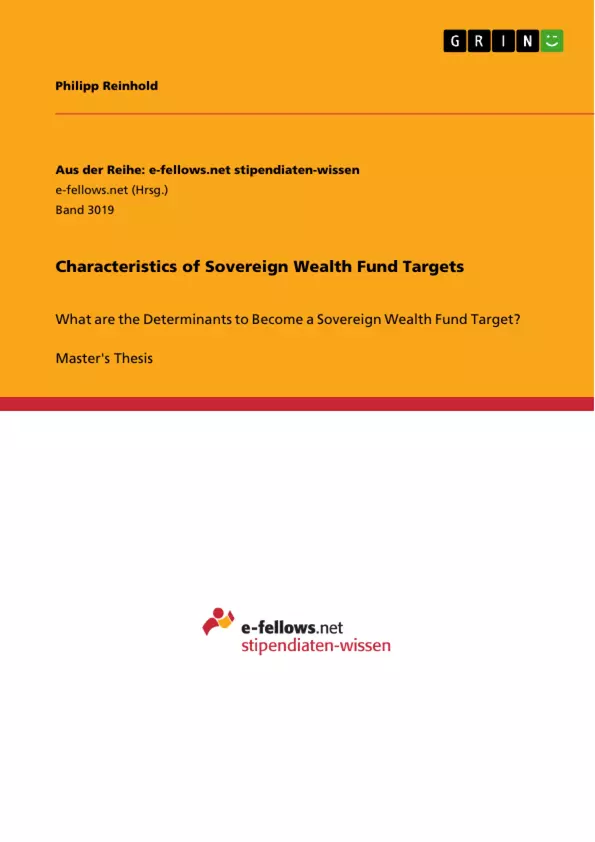Sovereign Wealth Funds (SWFs) have reached an enormous financial power and have tripled their assets under management to 7.4 trillion American dollars during the past ten years. So far, academia has focused on the most obvious characteristic of SWFs, the state ownership, and relating governance issues. This thesis answers the question of whether there are certain company characteristics, which are preferred by SWFs when investing, and which characteristics influence the ex-post probability of becoming a SWF target. For this purpose, the selected sample is compared to a set of Year, Industry, Size, and MTBV matched peers. First, systematic differences between targets and peers are identified using t-test and Wilcoxon rank sum test statistics. Second, the influence of variables on the ex-post probability of becoming a SWF target is analyzed using logistic panel regression models. The regression results are further discussed using odds ratios and marginal effects analysis. The main finding is that target companies are typically significantly larger than their matched peers, and the size of a company is identified to have the highest influence on the likelihood of becoming a target. This is accompanied by the finding that a higher proportion of held cash has a positive influence, and a higher book leverage ratio has a negative influence. Additionally, it is shown that there are no target characteristics, which would promote large or small-scale investments. As introduction into further research, it is analyzed how stock markets react on announced SWF investments. It is shown that excess returns of approximately one percent can be observed within a three-day event window.
Inhaltsverzeichnis (Table of Contents)
- Introduction
- Introducing Sovereign Wealth Funds
- The Rise of Sovereign Wealth Funds
- Definition of "Sovereign Wealth Fund"
- Funding Sources of SWFs
- Scientific Discussion about SWFs
- Data and Sample Overview
- Data Sources and Sample Selection
- Sovereign wealth fund transactions
- Unique company identifiers
- Financial information
- Sample Description
- Description of included observations
- Description of included SWFs
- Data Sources and Sample Selection
- Characteristics of SWF Targets
- Identifying Matched Peers
- Analysis of Target Characteristics
- Comparison of targets with matched peers
- The ex-post probability of getting targeted by SWFs
- Target characteristics of large versus small-scale investments
- Stock Market Reactions
- Conclusion
Zielsetzung und Themenschwerpunkte (Objectives and Key Themes)
This master thesis investigates the characteristics of companies targeted by Sovereign Wealth Funds (SWFs) and analyzes the factors influencing the probability of becoming a SWF target. The study aims to identify specific company characteristics that make them attractive to SWFs for investments. It also examines the impact of SWF investments on stock market reactions.
- Identifying company characteristics preferred by SWFs for investments.
- Analyzing the influence of these characteristics on the probability of becoming a SWF target.
- Investigating the impact of SWF investments on stock market reactions.
- Comparing target companies to matched peers to highlight potential differences.
- Utilizing logistic panel regression models to assess the influence of variables on the likelihood of becoming a SWF target.
Zusammenfassung der Kapitel (Chapter Summaries)
The thesis begins by introducing the concept of Sovereign Wealth Funds, exploring their rise, definition, funding sources, and existing scientific discussions. It then delves into the data sources and sample selection, outlining the selection criteria for analyzing SWF transactions and company data. The subsequent chapter focuses on identifying matched peers for target companies, analyzing target characteristics through comparison with peers, and evaluating the influence of these characteristics on the probability of becoming a SWF target. This chapter also examines target characteristics associated with large versus small-scale SWF investments. Finally, the thesis explores the impact of announced SWF investments on stock market reactions.
Schlüsselwörter (Keywords)
The primary keywords and focus topics of this thesis include Sovereign Wealth Funds, SWF investments, company characteristics, target companies, matched peers, logistic panel regression, stock market reactions, abnormal returns, and investment probability. The thesis utilizes empirical research methods to analyze the relationship between company characteristics and the probability of becoming a SWF target, contributing to the understanding of SWF investment behavior and market dynamics.
- Quote paper
- Philipp Reinhold (Author), 2018, Characteristics of Sovereign Wealth Fund Targets, Munich, GRIN Verlag, https://www.grin.com/document/454690



